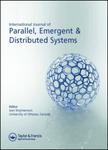版权所有:内蒙古大学图书馆 技术提供:维普资讯• 智图
内蒙古自治区呼和浩特市赛罕区大学西街235号 邮编: 010021

作者机构:Queens Univ Sch Comp Kingston ON K7L 3N6 Canada
出 版 物:《INTERNATIONAL JOURNAL OF PARALLEL EMERGENT AND DISTRIBUTED SYSTEMS》 (并行、紧急、分布式系统国际杂志)
年 卷 期:2020年第35卷第6期
页 面:668-681页
核心收录:
学科分类:08[工学] 0812[工学-计算机科学与技术(可授工学、理学学位)]
基 金:I am grateful to Pat Martin Marius Nagy Naya Nagy and Kai Salomaa for their helpful comments
主 题:Cryptography cryptanalysis cryptology encryption decryption secret key one-way function trapdoor one-way function graph multigraph plaintext ciphertext one-time key encryption algorithm encryption scheme public-key cryptosystem malleability confusion diffusion graph database homomorphic encryption social networks unconventional cryptographic function quantum cryptography protocol molecular encoding
摘 要:An algorithm is described for encrypting a graph to be transmitted securely from a sender to a receiver. In communications terminology, the graph is the message: its vertices, its edges, and its edge weights are the information to be concealed. The encryption algorithm is based on an unconventional mapping, conjectured to be a trapdoor one-way function, designed for graphs. This function requires the sender and the receiver to use a secret one-time encryption/decryption key. It is claimed that a malicious eavesdropper with no knowledge of the key will be faced with a computational task requiring exponential time in the size of the input graph in order to extract the original plaintext from the ciphertext carried by the encrypted graph. A number of variants to the main algorithm are also proposed.